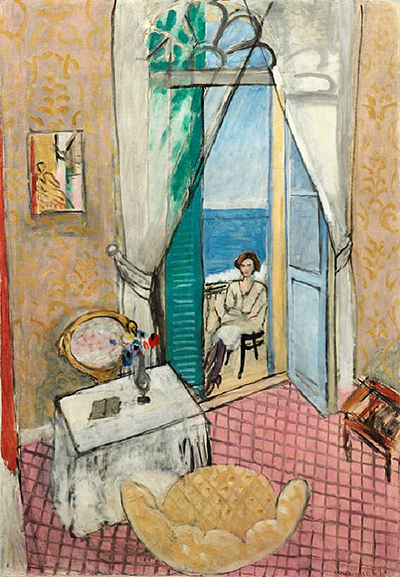Interior at Nice by Henri Matisse is typical of his best known style, using bright colour and composing a domestic scene with a view looking outside in the background. The south of France is known by artists for being saturated in light and Matisse himself discovered this during several visits around this region.
A young woman sits besides the door, with the sea placed behind her. A criss-cross patterned carpet sits below several items of furniture. Matisse liked to remove any elements from his compositions that he did not deem necessary to the overall balance. He also uses a flat perspective which is indicative of his movement towards modern art styles such as expressionism and post-impressionism. The abandonment of standard perspective will remind many of the work of young children with small crayons, and this is a fair assesment of modern art, where artists avoided the traditional formula of putting together objects. It was more about expressionism than realism. See also Interior with Phonograph for a related work with similar content and style.
That being said, most of these artists were technically very well trained, and more than capable of completing art in a more traditional style - they simply preferred not to. Matisse, for example, learnt from academically-approved painters such as Moreau and Bouguereau but moved away from that approach once he drew in other influences. This artwork feels 'happy' if you like, a long way from what we term as Matisse's Dark Period, when he used subdued tones that reflected his own personal problems and stresses on his wife's family's side. One can compare his quotes from these different periods as well as his art in order to understand his changing mood.
In this scene there is a small vase with bright flowers on a small table, covered by a white table cloth. A small couch sits alongside it but the abstract perspective makes it hard to identify on first viewing. There is a small window on the wall as well as a narrow painting which is used to cover an otherwise plain wall. Small touches of the brush provide a subtle pattern, presumably wallpaper. Some light curtains are draped across the door and these allow Matisse to experiment with light through thin material.




